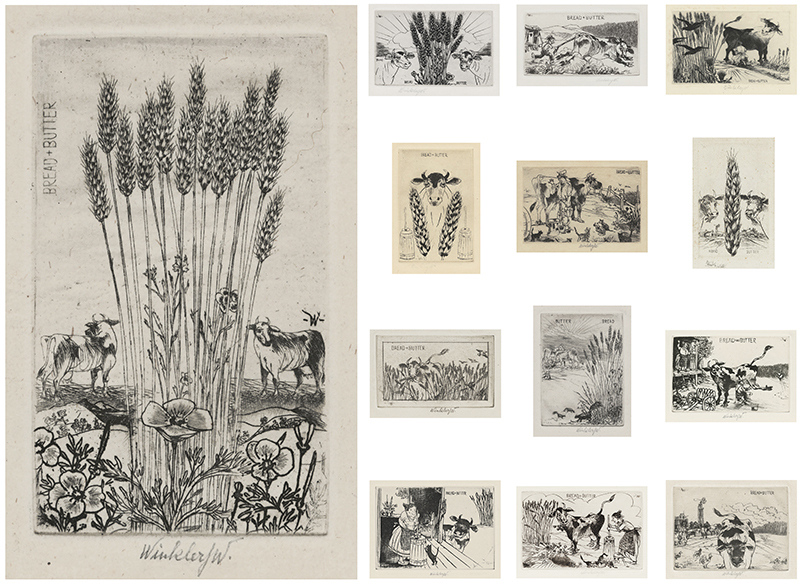
19th, 20th & 21st Century Fine Prints
707-546-7352 · fax 707-546-7924 · web: www.annexgalleries.com · email: artannex@aol.com
BREAD + BUTTER series by John William Winkler

















BREAD + BUTTER series
John William Winkler
BREAD + BUTTER series
John William Winkler
1894 - 1979 (biography)John Winkler based this whimsical, humorous series of miniature rural scenes featuring wheat and cows on sketches he made when he first arrived in the U.S. around 1910. After exploring New York City, he slowly made his way toward the storied West, searching for Wild Bill and adventure. He lived and worked for a brief time on farms in Nebraska owned by German immigrants, finally settling in San Francisco around 1912. This short lived farming life remained a source of inspiration for his "bread and butters" almost 40 years later.
These images refers to the wheat and dairy farming of his hosts. Some are ex libris-style graphics of cows wreathed in wheat stalks; others are scenes of a farm life. In one pastoral moment, a family of skunks emerges from the wheatfield as cows graze lazily in the background. In another, the wife churns cream on her porch as a curious kitten looks on. A series of four images depicts the farmer attempting to milk a cow, who becomes unwilling to be put to the task, kicking the milk pail away and running off. Winkler appears to have appreciated this small window of time in his life, as he created these images - of which none measure larger than 3-1/2" - nearly forty years after his arrival in America.
John William Joseph Winkler was born in Vienna, Austria on July 30, 1894. His family was of old money and military lineage and there appears to have been an expectation for Winkler to become a part of the Viennese government. When it became clear that young Winkler was bent on seeing America before settling down to such a future (claiming to have had "visions" of the Wild West), they agreed to fund one year's worth of travel to the United States. Documents written by Winkler state that he arrived in New York at the age of 16-1/2 and, according to Master of Line (Millmer, Mary and Bohn, Dave. Capra Press, 1994), he had enrolled in the Mark Hopkins Institute - now the San Francisco Art Instute - in San Francisco, California by November 1, 1912. Winkler would never return to Austria nor see his family again.
At the Mark Hopkins Institute he was introduced to etching by Frank Van Sloun. His first goal had been to learn "cartooning", but the apt pupil soon changed to a more realistic style inspired by the American painter-etcher movement as well as European Modernism. The Institute issued Winkler a lifelong scholarship, allowing the popular student to continue attending courses as needed, supporting himself as a lamplighter in Chinatown. This and Telegraph Hill, both culturally rich areas of the growing city, provided him with endless inspiration for his etchings. While on location, he was known to draw directly on prepared plates, including his earliest known series of architectural images documenting the construction of City Hall in 1914.
Departing for Europe in 1922, Winkler lived first in Paris and then in London over a period of seven years, sketching and drawing as he went. He not only drew cities and villages, but he appears to have visited the Lascaux caves of Dordogne with their Paleolithic-era wall paintings, as well, which would inspire a series of conte-crayon drawings of the subject. After returning to California in 1928 he reworked many of his city and country life images for etchings, and then focused his attention on California landscapes, creating a series of images of the Sierra Nevadas. Additionally, he began studying woodworking, which would replace printmaking for a time. In the early 1970s, he revived his interest in the etching medium, though many of these were not published before his death.

















